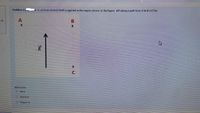Question

Transcribed Image Text:Problem 4
A uniform electric field is applied in the region shown in the figure. AV along a path from C to B will be.
t of
B.
X
Select one:
O Zero
O Positive
O Negative
Expert Solution
This question has been solved!
Explore an expertly crafted, step-by-step solution for a thorough understanding of key concepts.
This is a popular solution
Trending nowThis is a popular solution!
Step by stepSolved in 2 steps with 1 images

Knowledge Booster
Similar questions
- An electron starts from rest 33.0 cm from a fixed point charge with Q = -0.105 μC. Part A How fast will the electron be moving when it is very far away?arrow_forwardPart A In proton-beam therapy, a high-energy beam of protons is fired at a tumor. The protons come to rest in the tumor, depositing their kinetic energy and breaking apart the tumor's DNA, thus killing its cells. For one patient, it is desired that 0.10 J of proton energy be deposited in a tumor. To create the proton beam, the protons are accelerated from rest through a 15 MV potential difference. What is the total charge of the protons that must be fired at the tumor to deposit the required energy? Express your answer with the appropriate units. Value = b6 Units Submit Request Answer Provide Feedback IIarrow_forwardX FEED QUESTION 4 A particle of charge +6.1 µC is released from rest at the point x = 98 cm on an x axis. The particle begins to move due to the presence of a charge Q=+89 µC that remains fixed at the origin. What is the kinetic energy of the particle at the instant it has moved 40 cm? OA. 1.443 J OB. 0.334 J OC.0.155 J OD.3.434 J OE. 1.983 J BE ents the magnitude of the electric field as a function of the distance from the center of a solid charged conductingarrow_forward
- I Review | Constants The ammonia molecule (NH3) has a dipole moment of 5.0 x 10-30 C.m. Ammonia molecules in the gas phase are placed in a uniform electric field E with magnitude 1.4x106 N/C. Part A What is the change in electric potential energy when the dipole moment of a molecule changes its orientation with respect to E from parallel to perpendicular? Express your answer using two significant figures. ΑΣφ ? AU = Jarrow_forward10 nC B. A -5 nC You wish to place a charge at A, which when released will move away from the two charges shown, and then determine the speed of the charge when it gets an infinite distance away from the two charges. The rectangle is 18.4 cm high and 21.9 cm wide. In order for the charge placed at A to move to infinity, you must use an electron a proton When released, approximately which direction will the charge initially accelerate? Image an analog clock face placed at A with 12 o'clock upward. toward ---Select--- v o'clock How fast will the charge be moving when it gets an infinite distance from the two charges? m/sarrow_forwardO Part B Two parallel plates each have an area of 35.5 cm-. Between the plates is a dielectric with K = 52. If the charge magnitude on each plate is 2.1 nC, determine the E-field between the plates. E =arrow_forward
- Pls helparrow_forwardPart A How far must the point charges qi = 7.10 µC and q2 = -26.1 µC be separated for the electric potential energy of the system to be -166 J ? r = cm Submit Request Answer Provide Feedback Next >arrow_forwardThree, equal, positive, point charges are moved through a uniform electric field as shown in the diagram below. Let W1, W2, and W3 equal the amount of work done by the electric field on charges q1, q2, and q3 respectively. Which of the following statements is true? a. W3 < W2 < W1 b. W2 > W3 > W1 c. W1 = W2 = W3 d. W1 < W2 < W3 e. W1 > W3 > W2arrow_forward
- 3. A positive charge of magnitude q, is shown at the right. Points B and C are a distance ro from the charge and point A is a distance 2r. from it. Let WAB represent the work done by an external agent in moving a small test charge from point A to point B. a. Use an arrow to indicate the direction of the electric field at points A, B, and C. X A X B X C qo b. Would the absolute value of the work done by an external agent in moving the same test charge from point B to point C be greater than, less than, or equal to WAB? Explain. c. Would the absolute value of the work done by an external agent in moving the same test charge from point A to point C be greater than, less than, or equal to WAB? Explain.arrow_forwardĒ 4περτ2 This problem checks your understanding of the term in the equation for the electric field due to a point charge, Consider a charged particle at a point S whose coordinates are (10 m, 10 m, 7 m). We would like to find the electric field vector at a point P whose coordinates are (4 m, 5 m, 5 m). The term is the distance between point S and point P. What is its value, in meters? 1 Q ↑arrow_forward
arrow_back_ios
arrow_forward_ios